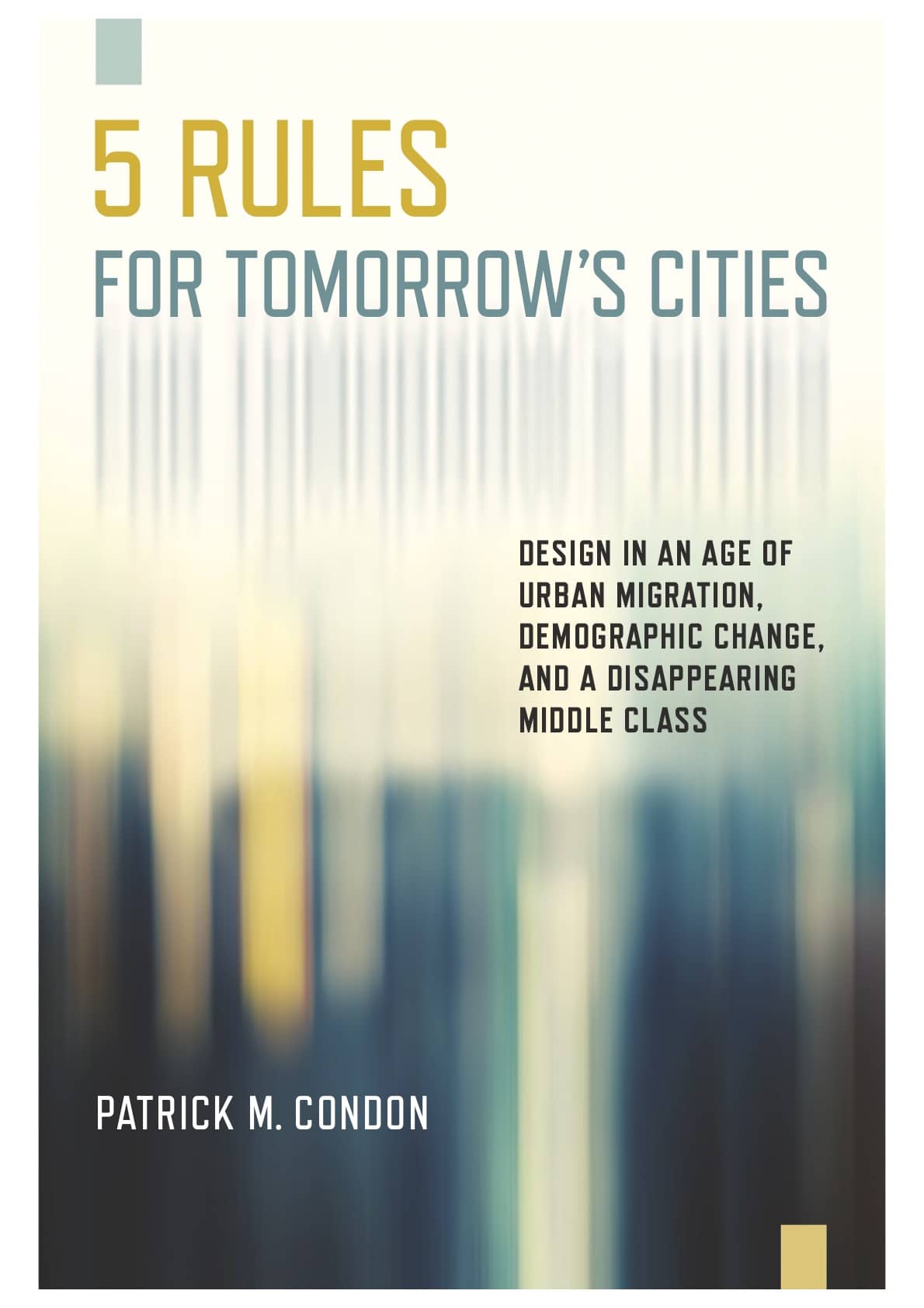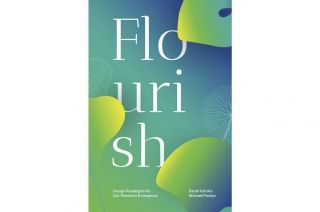
www.buildingsandcities.org/insights/reviews/five-rules-tomorrows-cities.html
Five Rules for Tomorrow's Cities: Design in an Age of Urban Migration, Demographic Change, and a Disappearing Middle Class
By Patrick M. Condon. Springer, 2019, ISBN: 9781610919616
Joe Ravetz reviews this book, which explores the changing nature of cities and proposes five rules for effective urban planning and design.
This is an important and timely
book - not as an academic treatise, but a genuine attempt to bring some
fundamental ideas into the ha nds of urban practitioners and the public. It rightly enlarges the scope and role of
'urban design' to include for the interconnections of social, economic,
cultural and ecological systems. With such a broad canvas, gaps and flaws are perhaps
inevitable, but these are outweighed by the agenda.
nds of urban practitioners and the public. It rightly enlarges the scope and role of
'urban design' to include for the interconnections of social, economic,
cultural and ecological systems. With such a broad canvas, gaps and flaws are perhaps
inevitable, but these are outweighed by the agenda.
The book's first proposition is that three global waves are changing the nature of cities, and that systems / complexity thinking, as seen in different ways in the works of Jane Jacobs and Christopher Alexander, have the potential to turn such problems into opportunities (Jacobs 1965, Alexander et al. 1978).
One wave is rural-to-urban migration, not a new phenomenon, but perhaps entering a new phase in large parts of the world. However this book frames migration as a simple binary divide, with few nuances such as the changing roles of larger or medium cities, the extended areas of sprawl and/or peri-urbanization, or the complexities of counter-urbanization. A second wave is the demographic transition of falling birth rates (in most parts of the world), and its implications for urban expansion and 'urban ageing'. A third wave is titled 'the end of the middle class', and paints a stark picture of rising inequality and polarization. Again the evidence is far more complex, and the book would do well to include transitions in progress in Asia and Africa, with a rather different picture of a fast-growing urban middle class, either as service workers, knowledge workers or in partial work of some kind (Karas 2017).
From this the book generates 'Five Rules' as propositions and discussions, with colourful examples both from cities around the world, and from the author's own practice.
Rule 1 is to 'See the City as a System', a direct application of systems thinking, with an example of collaborative community based planning - this seems all positive but too often bypasses the challenges of hierarchies, power games, extractive relations and other conundrums. Rule 2 is about the 'Patterns in Urban Environments', with reference to Alexander's journey through the Pattern Language and beyond: where physical systems design codes or 'patterns', from building details to regional strategies, are enablers for integration and harmony in human systems, social, economic, cultural or political. Rule 3 is a topical application of 'Lighter, Greener, Smarter Infrastructure', which promotes distributed forms of infrastructure as the enabler of self-organizing localized service units.
Rule 4, 'Strengthen Social Resilience through Affordable Housing Design', starts to provide real substance, with an extended discourse on densification, land speculation, design codes in Vancouver, and with reference to social housing in 1920s 'Red Vienna'. The message here is crucial - that participative design, plot ratio policies and community resilience can all combine, not only in the favelas and barrios, but in the modern metropolis. Such a space of potential lies between what is practical in current conditions, and more structural reforms of housing tenure and property rights.
Finally, Rule 5 takes an economic development angle, with 'Shifts in Jobs, Retail, and Wages': this is a powerful argument on networked agile self-organizing livelihoods. It deserves further development, even if very sketchy here, with reference to the capitalist analysis of Piketty (2014) and a post-war mythology of vanishing prosperity and security.
All this is illustrated with copious examples, presented as a kind of speed conversation. One can forgive the many gaps and flaws: the text mistakes 'parabolic growth' for 'exponential' (p14) and quotes the Millennium Development Goals which have been superseded by the Sustainable Development Goals. As for the famous Medellin (Columbia) experiments in urban acupuncture (p 42) - the 'slum escalators' are seen on the ground as (costly) gimmicks, the iconic cable cars serve only a fraction of the favelas, and meanwhile private high rise 'urbanisation' continues with security guards and underground parking. And in the discussion of over-valued land / housing markets and the topical ideas on 'hiving' or planned subdivision, there is a blanket assumption that the 'market has failed' for average income households - again reality could be rather more complex.
Even with such shortcomings, the book's proposition deserves to be taken forwards, both in theory and in practice, as a genuine attempt to bring urban systems thinking into practical application. Creative practitioners of many kinds may gain something useful - designers, urban planners, housing providers, students and campaigners - and hopefully, socially conscious landlords and builders. As of 2021 the pandemic may serve to accelerate new thinking in urban planning and design, real estate, housing management and transport policy, as society moves online, and both workers and consumers are now local or multi-locational. The neo-liberal model of top-down corporate design with mono-functional private housing and profit-focused services, may already be morphing into something more self-organizing, with mutual learning and exchange between a wider set of stakeholders, with deeper layers of value and meaning. With cities as arenas not only for citizens and communities, but also for power and expropriation, it seems the future will not be straightforward - but it will surely be interesting.
References:
Alexander, C., Silverstein, M. and Ishikawa, S. (1977). A Pattern Language: Towns, Buildings, Construction. Oxford: Oxford University Press.
Jacobs J. (1965). The Death and Life of Great American Cities, Harmondsworth, UK: Penguin.
Karas, H. (2017). The unprecedented expansion of the global middle class: an update. Washington, DC: Brookings Institute.
Piketty,
T. (2014). Capital in the 21st
Century, Cambridge, MA: Harvard University Press.
Latest Peer-Reviewed Journal Content
Net zero retrofit of the building stock [editorial]
D Godoy-Shimizu & P Steadman
Co-learning in living labs: nurturing civic agency and resilience
A Belfield
The importance of multi-roles and code-switching in living labs
H Noller & A Tarik
Researchers’ shifting roles in living labs for knowledge co-production
C-C Dobre & G Faldi
Increasing civic resilience in urban living labs: city authorities’ roles
E Alatalo, M Laine & M Kyrönviita
Co-curation as civic practice in community engagement
Z Li, M Sunikka-Blank, R Purohit & F Samuel
Preserving buildings: emission reductions from circular economy strategies in Austria
N Alaux, V Kulmer, J Vogel & A Passer
Urban living labs: relationality between institutions and local circularity
P Palo, M Adelfio, J Lundin & E Brandão
Living labs: epistemic modelling, temporariness and land value
J Clossick, T Khonsari & U Steven
Co-creating interventions to prevent mosquito-borne disease transmission in hospitals
O Sloan Wood, E Lupenza, D M Agnello, J B Knudsen, M Msellem, K L Schiøler & F Saleh
Circularity at the neighbourhood scale: co-creative living lab lessons
J Honsa, A Versele, T Van de Kerckhove & C Piccardo
Positive energy districts and energy communities: how living labs create value
E Malakhatka, O Shafqat, A Sandoff & L Thuvander
Built environment governance and professionalism: the end of laissez-faire (again)
S Foxell
Co-creating justice in housing energy transitions through energy living labs
D Ricci, C Leiwakabessy, S van Wieringen, P de Koning & T Konstantinou
HVAC characterisation of existing Canadian buildings for decarbonisation retrofit identification
J Adebisi & J J McArthur
Simulation and the building performance gap [editorial]
M Donn
Developing criteria for effective building-sector commitments in nationally determined contributions
P Graham, K McFarlane & M Taheri
Reimagining circularity: actions for optimising the use of existing buildings
R Lundgren, R Kyrö, S Toivonen & L Tähtinen
Effective interdisciplinary stakeholder engagement in net zero building design
S Vakeva-Baird, F Tahmasebi, JJ Williams & D Mumovic
Metrics for building component disassembly potential: a practical framework
H Järvelä, A Lehto, T Pirilä & M Kuittinen
The unfitness of dwellings: why spatial and conceptual boundaries matter
E Nisonen, D Milián Bernal & S Pelsmakers
Environmental variables and air quality: implications for planning and public health
H Itzhak-Ben-Shalom, T Saroglou, V Multanen, A Vanunu, A Karnieli, D Katoshevski, N Davidovitch & I A Meir
Exploring diverse drivers behind hybrid heating solutions
S Kilpeläinen, S Pelsmakers, R Castaño-Rosa & M-S Miettinen
Urban rooms and the expanded ecology of urban living labs
E Akbil & C Butterworth
Living with extreme heat: perceptions and experiences
L King & C Demski
A systemic decision-making model for energy retrofits
C Schünemann, M Dshemuchadse & S Scherbaum
Modelling site-specific outdoor temperature for buildings in urban environments
K Cebrat, J Narożny, M Baborska-Narożny & M Smektała
Understanding shading through home-use experience, measurement and modelling
M Baborska-Narożny, K Bandurski, & M Grudzińska
Building performance simulation for sensemaking in architectural pedagogy
M Bohm
Beyond the building: governance challenges in social housing retrofit
H Charles
Heat stress in social housing districts: tree cover–built form interaction
C Lopez-Ordoñez, E Garcia-Nevado, H Coch & M Morganti
An observational analysis of shade-related pedestrian activity
M Levenson, D Pearlmutter & O Aleksandrowicz
Learning to sail a building: a people-first approach to retrofit
B Bordass, R Pender, K Steele & A Graham
Market transformations: gas conversion as a blueprint for net zero retrofit
A Gillich
Resistance against zero-emission neighbourhood infrastructuring: key lessons from Norway
T Berker & R Woods
Megatrends and weak signals shaping future real estate
S Toivonen
A strategic niche management framework to scale deep energy retrofits
T H King & M Jemtrud
Generative AI: reconfiguring supervision and doctoral research
P Boyd & D Harding
Exploring interactions between shading and view using visual difference prediction
S Wasilewski & M Andersen
How urban green infrastructure contributes to carbon neutrality [briefing note]
R Hautamäki, L Kulmala, M Ariluoma & L Järvi
Implementing and operating net zero buildings in South Africa
R Terblanche, C May & J Steward
Quantifying inter-dwelling air exchanges during fan pressurisation tests
D Glew, F Thomas, D Miles-Shenton & J Parker
Western Asian and Northern African residential building stocks: archetype analysis
S Akin, A Eghbali, C Nwagwu & E Hertwich
Join Our Community

The most important part of any journal is our people – readers, authors, reviewers, editorial board members and editors. You are cordially invited to join our community by joining our mailing list. We send out occasional emails about the journal – calls for papers, special issues, events and more.
We will not share your email with third parties. Read more



Latest Commentaries
Building-Related Research: New Context, New Challenges
Raymond J. Cole (University of British Columbia) reflects on the key challenges raised in the 34 commissioned essays for Buildings & Cities 5th anniversary. Not only are key research issues identified, but the consequences of changing contexts for conducting research and tailoring its influence on society are highlighted as key areas of action.
Lessons from Disaster Recovery: Build Better Before
Mary C. Comerio (University of California, Berkeley) explains why disaster recovery must begin well before a disaster occurs. The goal is to reduce the potential for damage beforehand by making housing delivery (e.g. capabilities and the physical, technical and institutional infrastructures) both more resilient and more capable of building back after disasters.